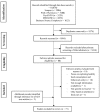Food Marketing Influences Children's Attitudes, Preferences and Consumption: A Systematic Critical Review
- PMID: 31003489
- PMCID: PMC6520952
- DOI: 10.3390/nu11040875
Food Marketing Influences Children's Attitudes, Preferences and Consumption: A Systematic Critical Review
Abstract
Exposure to the marketing of unhealthy foods and beverages is a widely acknowledged risk factor for the development of childhood obesity and noncommunicable diseases. Food marketing involves the use of numerous persuasive techniques to influence children's food attitudes, preferences and consumption. This systematic review provides a comprehensive contemporary account of the impact of these marketing techniques on children aged 0-18 years and critically evaluates the methodologies used. Five electronic academic databases were searched using key terms for primary studies (both quantitative and qualitative) published up to September 2018; 71 eligible articles were identified. Significant detrimental effects of food marketing, including enhanced attitudes, preferences and increased consumption of marketed foods were documented for a wide range of marketing techniques, particularly those used in television/movies and product packaging. Together, these studies contribute strong evidence to support the restriction of food marketing to children. However, the review also signposted distinct gaps: Firstly, there is a lack of use of qualitative and physiological methodologies. Secondly, contemporary and sophisticated marketing techniques used in new media warrant increased research attention. Finally, more research is needed to evaluate the longer-term effects of food marketing on children's weight.
Keywords: childhood obesity; food marketing; marketing techniques; systematic review; vehicles of marketing.
Conflict of interest statement
The authors declare no conflicts of interest. The Australian Research Council played no part in the conceptualisation or methodology of this systematic review, the drafting of the manuscript or the decision to submit the paper for publication.
Figures
Similar articles
-
Food marketing to children in Canada: a settings-based scoping review on exposure, power and impact.Health Promot Chronic Dis Prev Can. 2017 Sep;37(9):274-292. doi: 10.24095/hpcdp.37.9.03. Health Promot Chronic Dis Prev Can. 2017. PMID: 28902477 Free PMC article.
-
Remember Me? Exposure to Unfamiliar Food Brands in Television Advertising and Online Advergames Drives Children's Brand Recognition, Attitudes, and Desire to Eat Foods: A Secondary Analysis from a Crossover Experimental-Control Study with Randomization at the Group Level.J Acad Nutr Diet. 2020 Jan;120(1):120-129. doi: 10.1016/j.jand.2019.05.006. Epub 2019 Jul 10. J Acad Nutr Diet. 2020. PMID: 31302037
-
Contemporary digital marketing techniques used in unhealthy food campaigns targeting young people.Appetite. 2025 Jul 1;211:107989. doi: 10.1016/j.appet.2025.107989. Epub 2025 Apr 2. Appetite. 2025. PMID: 40185242
-
A qualitative study of children's snack food packaging perceptions and preferences.BMC Public Health. 2014 Dec 15;14:1274. doi: 10.1186/1471-2458-14-1274. BMC Public Health. 2014. PMID: 25511663 Free PMC article.
-
Parents' Perceptions of Children's Exposure to Unhealthy Food Marketing: a Narrative Review of the Literature.Curr Nutr Rep. 2022 Mar;11(1):9-18. doi: 10.1007/s13668-021-00390-0. Epub 2022 Mar 12. Curr Nutr Rep. 2022. PMID: 35278205 Free PMC article. Review.
Cited by
-
The Timing, Nature and Extent of Social Media Marketing by Unhealthy Food and Drinks Brands During the COVID-19 Pandemic in New Zealand.Front Nutr. 2021 Mar 5;8:645349. doi: 10.3389/fnut.2021.645349. eCollection 2021. Front Nutr. 2021. PMID: 33748177 Free PMC article.
-
Development of a questionnaire for assessing the impact of children's food marketing exposure on diet-related outcomes.BMJ Nutr Prev Health. 2024 Jun 4;7(1):174-182. doi: 10.1136/bmjnph-2024-000912. eCollection 2024. BMJ Nutr Prev Health. 2024. PMID: 38966107 Free PMC article.
-
Comparing Latin American nutrient profile models using data from packaged foods with child-directed marketing within the Brazilian food supply.Front Nutr. 2022 Dec 2;9:920710. doi: 10.3389/fnut.2022.920710. eCollection 2022. Front Nutr. 2022. PMID: 36532519 Free PMC article.
-
Food Insecurity and the Association between Perceptions and Trust of Food Advertisements and Consumption of Ultra-Processed Foods among U.S. Parents and Adolescents.Nutrients. 2022 May 7;14(9):1964. doi: 10.3390/nu14091964. Nutrients. 2022. PMID: 35565932 Free PMC article.
-
Adolescents' exposure to and evaluation of food promotions on social media: a multi-method approach.Int J Behav Nutr Phys Act. 2022 Jun 27;19(1):74. doi: 10.1186/s12966-022-01310-3. Int J Behav Nutr Phys Act. 2022. PMID: 35761362 Free PMC article.
References
-
- Abarca-Gómez L., Abdeen Z.A., Hamid Z.A., Abu-Rmeileh N.M., Acosta-Cazares B., Acuin C., Adams R.J., Aekplakorn W., Afsana K., Aguilar-Salinas C.A., et al. Worldwide trends in body-mass index, underweight, overweight, and obesity from 1975 to 2016: A pooled analysis of 2416 population-based measurement studies in 128·9 million children, adolescents, and adults. Lancet. 2017;390:2627–2642. doi: 10.1016/S0140-6736(17)32129-3. - DOI - PMC - PubMed
-
- World Health Organization . Noncommunicable Diseases: Progress Monitor 2017. World Health Organization; Geneva, Switzerland: 2017. Report No.: 9241513020.
-
- World Health Organization . Obesity and Overweight. World Health Organization; Geneva, Switzerland: Nov 6, 2018.
Publication types
MeSH terms
Grants and funding
LinkOut - more resources
Full Text Sources


